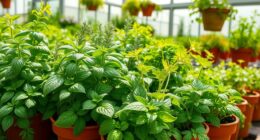To prevent pests in your greenhouse and keep your plants healthy, focus on effective design, sanitation, and integrated pest management. Install insect screens and maintain proper ventilation to minimize pest entry. Regularly clean surfaces and manage plant debris while promoting plant health through crop rotation and diverse species. Use beneficial insects for natural control and monitor your environment closely. Discover how these practices can blend together for an even healthier greenhouse ecosystem.
Key Takeaways
- Install insect screens on air intakes and use airlocks to minimize pest entry into the greenhouse.
- Maintain rigorous sanitation practices by regularly cleaning tools, benches, and floors to eliminate pest habitats.
- Control the greenhouse environment with proper ventilation, humidity management, and adequate plant spacing for healthy growth.
- Utilize biological control methods by introducing beneficial insects like ladybugs and lacewings to manage pest populations naturally.
- Implement Integrated Pest Management (IPM) strategies that combine cultural, biological, and mechanical controls for a balanced ecosystem.
Effective Greenhouse Design and Screening Techniques
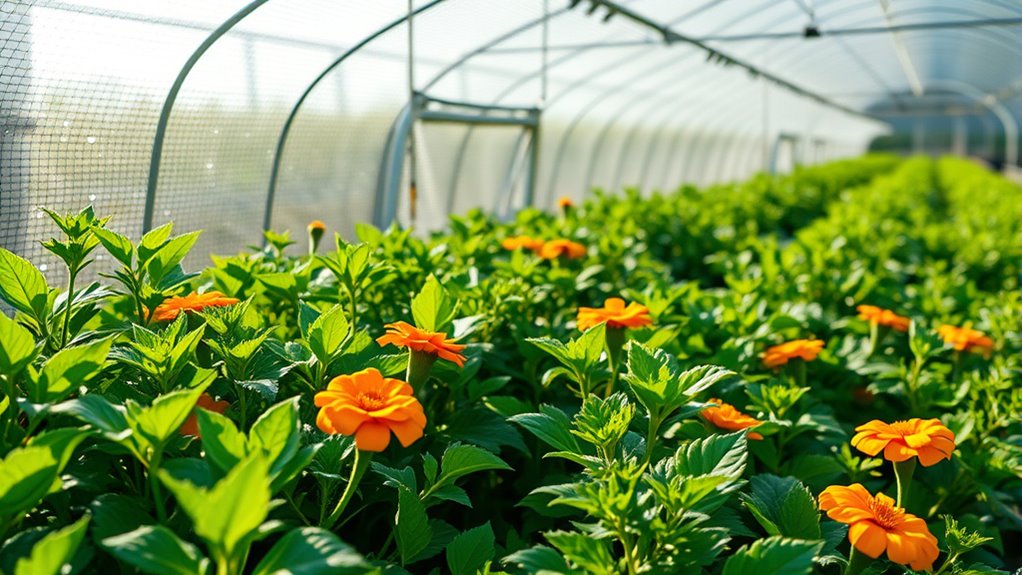
When designing a greenhouse, you can greatly enhance pest prevention by incorporating effective design and screening techniques.
Start by installing insect screens on all air intakes to block pests like whiteflies and thrips. Adding airlocks or vestibules at entry points helps maintain a clean environment by minimizing pest introduction.
Incorporate insect screens and airlocks to effectively minimize pest introduction in your greenhouse.
Proper ventilation systems are essential too, as they reduce humidity and temperature fluctuations, making conditions less favorable for pests.
Guarantee adequate plant spacing to promote healthy growth and limit pest spread.
Finally, use raised benches and maintain clean floors to minimize hiding spots for pests and facilitate easier cleaning.
These design choices create a proactive barrier against pests, guaranteeing your greenhouse thrives.
Importance of Sanitation Practices in Pest Control
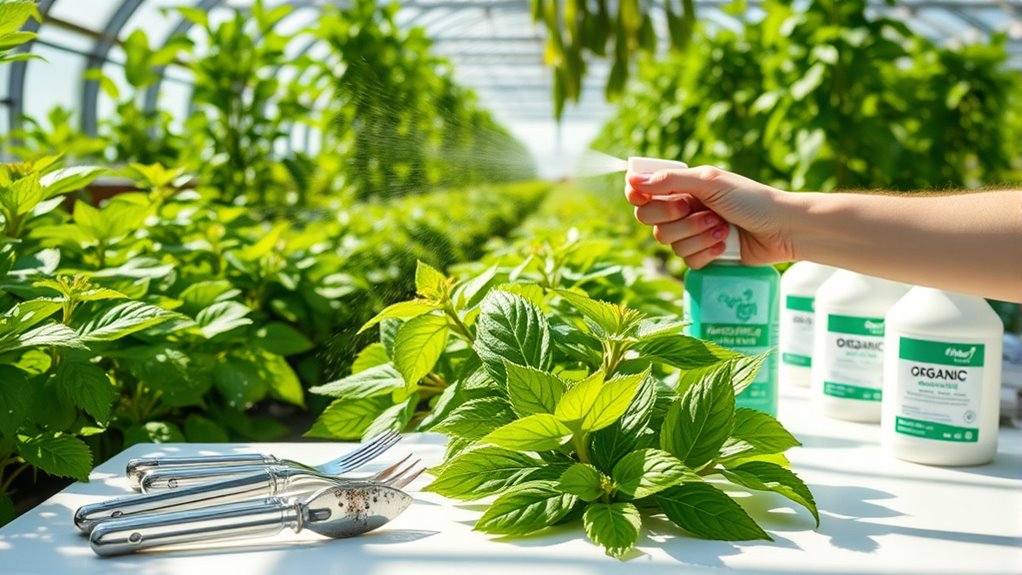
Sanitation practices are essential for effective pest control in greenhouses, as they help eliminate potential pest habitats and reduce disease risks. By removing weeds, you cut off refuges for pests like aphids and whiteflies.
Regularly cleaning benches and floors prevents algae buildup, which can harbor pathogens. It's imperative to manage plant debris by using sealed containers for disposal, ensuring pests have no shelter.
Clean tools and equipment also play an important role in preventing disease spread. Establishing a routine sanitation schedule not only reduces the need for chemical pesticides but also promotes healthier plants, improves air circulation, and supports sustainable practices.
Ultimately, prioritizing sanitation enhances your greenhouse's overall productivity and long-term success.
Cultural Practices for Promoting Plant Health
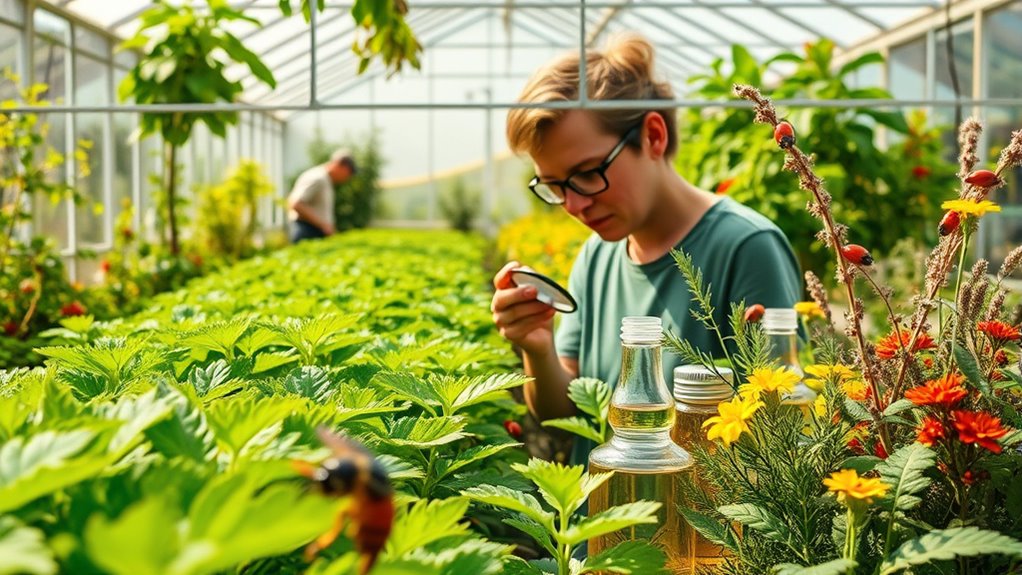
To foster robust plant health in your greenhouse, implementing effective cultural practices is essential.
Start by managing your greenhouse environment; control temperatures and humidity to minimize pest development and moisture-related diseases. Guarantee proper light exposure and good air circulation to promote growth and reduce disease risks.
Utilize crop rotation and timely plantings to disrupt pest life cycles, and schedule fallow periods to eliminate pest habitats. Select resistant plant varieties and certified disease-free materials to further reduce potential issues.
Maintain weed-free zones and regularly remove debris to prevent pest harborage. Prune plants to improve air circulation and monitor their health consistently, addressing any signs of stress promptly. Additionally, incorporating effective pest management strategies will further enhance your greenhouse's resilience against infestations.
These practices will create a thriving environment for your plants.
Utilizing Biological Control Methods
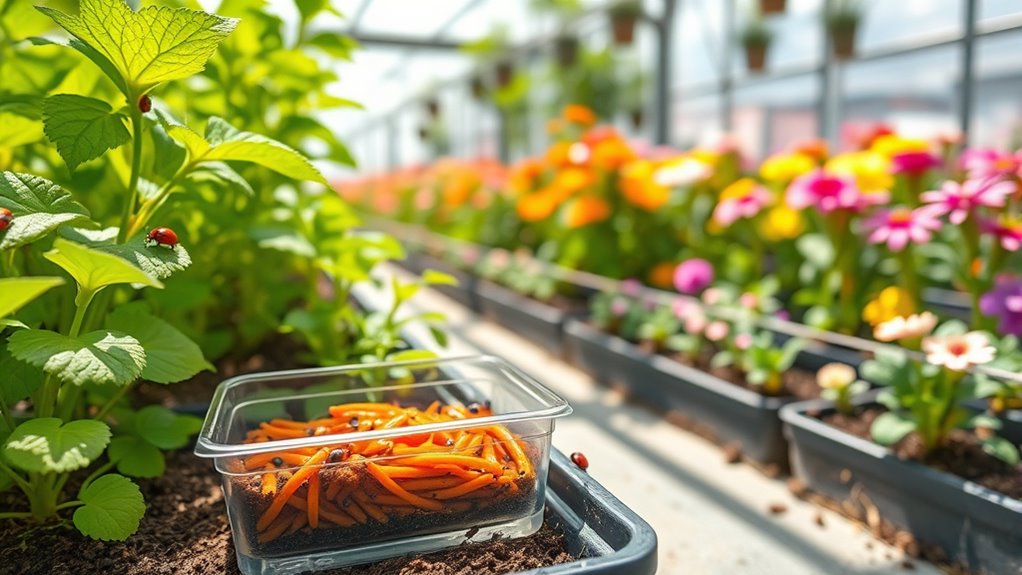
Biological control methods offer an effective and environmentally friendly approach to managing pests in your greenhouse.
By introducing predatory insects like ladybugs and lacewings, you can target pests such as aphids and whiteflies. Beneficial mites, like Phytoseiulus persimilis, can help control spider mite populations, while Steinernema nematodes attack fungus gnat larvae.
Fungi and bacteria can also be used to infect and manage pests. These methods reduce the need for chemical pesticides, lowering environmental impact and resistance risks.
You can implement these strategies through augmentative, inoculative, or inundative releases, depending on your needs. Regular monitoring and environmental adjustments will guarantee your biological control agents thrive, making your greenhouse healthier and more sustainable.
Natural Pest Repellents for a Healthy Greenhouse
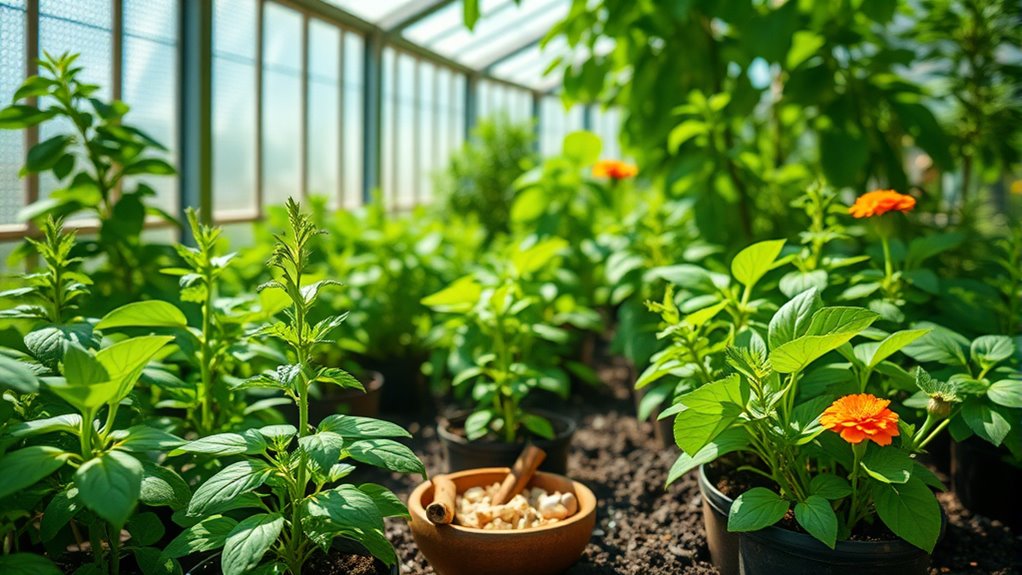
While pests can threaten the health of your greenhouse, using natural pest repellents can effectively minimize their impact.
Marigolds are excellent as they attract pollinators while repelling various pests. Incorporate rosemary to deter cabbage loopers and carrot flies, and plant petunias to keep aphids and tomato hornworms at bay.
Lemongrass controls mosquitoes and whiteflies, while chamomile enhances biodiversity and acts as a pest repellent.
You can also make homemade sprays, like a chili and garlic mixture, to repel unwanted insects. Diatomaceous earth serves as a natural barrier, damaging the exoskeletons of crawling pests.
Regularly using these natural methods guarantees a healthier greenhouse environment, promoting plant vigor without harsh chemicals.
Implementing Integrated Pest Management (IPM)
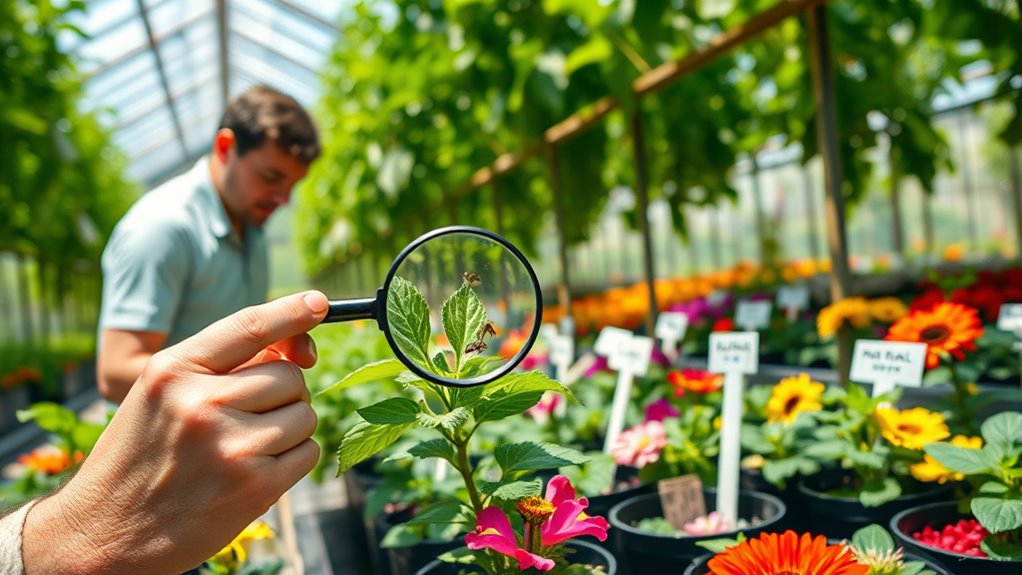
Natural pest repellents offer a strong foundation for protecting your greenhouse, but implementing Integrated Pest Management (IPM) takes your pest control strategies to the next level.
IPM is a holistic approach that combines cultural, biological, physical, mechanical, and chemical controls to manage pest populations at tolerable levels.
Start by screening doors and vents to keep pests out, and maintain sanitation to prevent infestations.
Regularly inspect incoming plants and control weeds to eliminate pest habitats.
Consider introducing natural predators and beneficial insects to effectively manage pests.
Remember, the goal isn't to eradicate pests entirely but to maintain a balanced ecosystem while minimizing environmental impact.
With IPM, you're investing in long-term pest management that's both effective and sustainable.
Monitoring and Record Keeping for Pest Management
Effective pest management hinges on thorough monitoring and precise record keeping, as these practices allow you to identify issues early and respond swiftly.
Start with regular visual observations of plants for pests like aphids and spider mites. Employ sticky traps in a grid pattern to capture flying insects. Conduct weekly inspections, moving in a zig-zag pattern to guarantee you cover all areas.
Use monitoring forms to record your findings and maintain maps to track pest movement. Document crop stages and treatment records to refine your strategies. Analyze pest population trends and adjust your management tactics as needed.
The Role of Ventilation in Pest Prevention
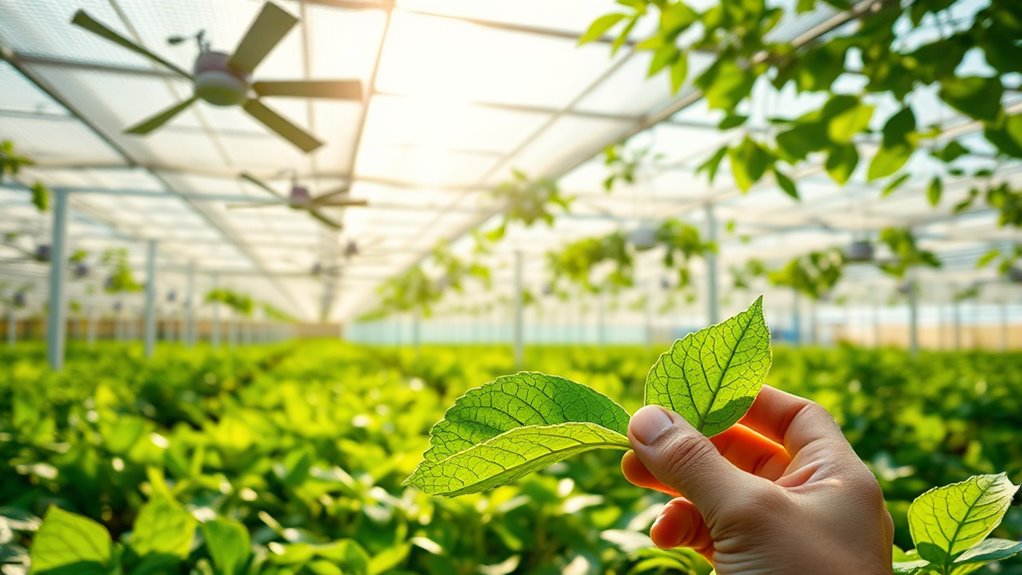
Ventilation plays an essential role in preventing pest infestations in your greenhouse, as it not only regulates temperature but also manages humidity levels.
Proper airflow reduces humidity, making your greenhouse less attractive to pests while promoting healthy plant growth. You can use roof vents, side vents, and louver windows to create an effective ventilation system.
Don't forget to install insect screens to block pests like whiteflies and thrips from entering. Airlocks at entry points further help keep pests out.
Regular maintenance of your ventilation system is vital to guarantee it operates efficiently. By managing airflow and humidity, you create an environment that discourages pests and supports your plants' health.
Maintaining Cleanliness in Walkways and Surfaces
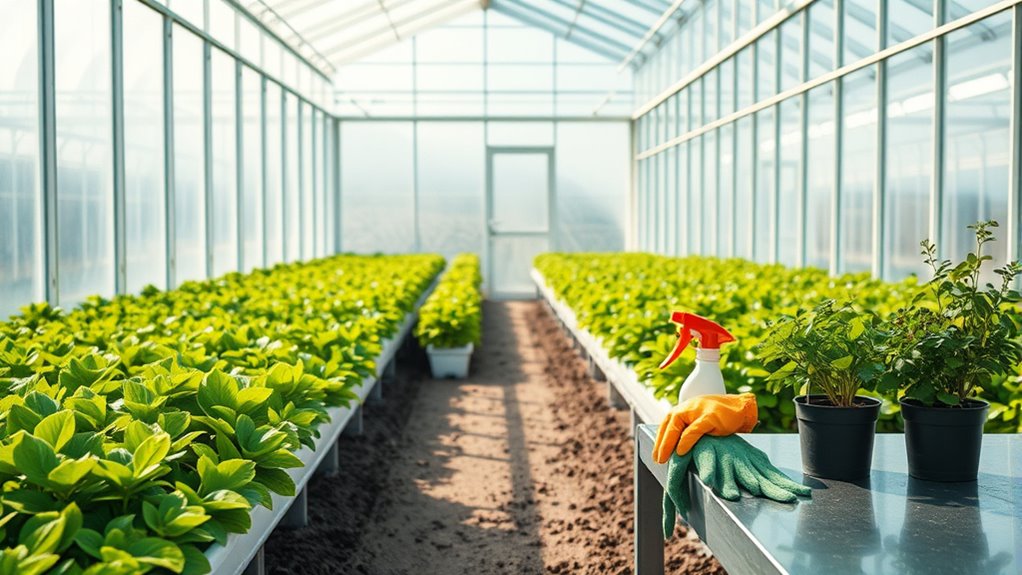
While keeping your greenhouse clean might seem like a simple task, it's essential for preventing pest infestations and promoting plant health.
Start by regularly removing debris from walkways and surfaces to minimize pest and pathogen accumulation. Opt for concrete floors, as they're easier to sanitize than soil or wood. Power wash these surfaces with soap and water before applying disinfectants like bleach to eliminate harmful pathogens.
Don't forget to control weeds, both inside and outside the greenhouse, as they can harbor pests. Establish a routine cleaning schedule for all equipment, using metal benches that are easier to clean compared to wood.
Enhancing Biodiversity for Natural Pest Control
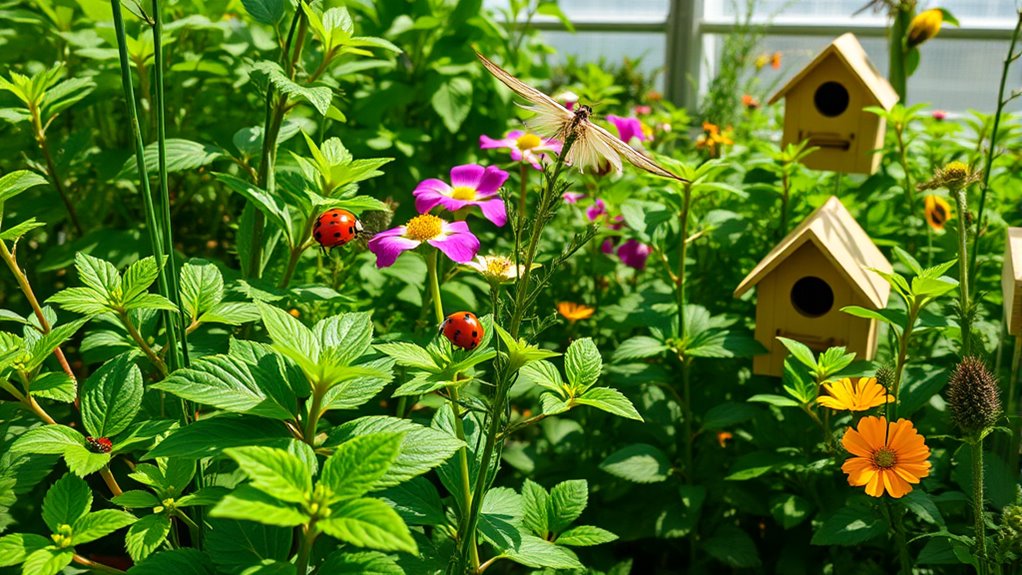
As you aim for a pest-free greenhouse, enhancing biodiversity can be a powerful ally in your efforts. By promoting a variety of plants, you'll attract beneficial insects like ladybugs and parasitic wasps that help control pesky populations.
Implementing practices such as polyculture and planting flowering herbs not only boosts biodiversity but also nurtures natural enemy communities. Surrounding your greenhouse with natural habitats, like woody areas and grasslands, can further enhance pest control by drawing in these helpful insects.
While there may be a slight risk of increased pest influx, the benefits of reduced chemical use and improved ecosystem services, like pollination, far outweigh the concerns.
Embrace biodiversity to create a healthier, more resilient greenhouse environment.
Frequently Asked Questions
How Often Should I Inspect My Greenhouse for Pests?
You should inspect your greenhouse regularly to catch pests early. Aim for weekly inspections, or even twice a week during busy seasons.
Daily checks of indicator plants and sticky traps are ideal for spotting issues before they escalate. Spend at least 10 minutes looking at 20 or more plants for every 1,000 square feet.
Use a zig-zag pattern to guarantee you cover all areas effectively. Keeping consistent checks helps maintain a healthy environment.
What Are the Signs of a Pest Infestation?
Imagine walking through your lush greenhouse, only to notice leaves curling and turning yellow—an unsettling sign of a pest infestation.
You might spot tiny, soft-bodied aphids or the fine webbing of spider mites hiding beneath the leaves.
Whiteflies flutter away as you approach, while fungus gnats buzz around the soil.
If you see these signs, it's essential to act fast to protect your plants from further damage and decline.
Can Pests Survive Winter in a Greenhouse?
Yes, pests can survive winter in a greenhouse. You might find aphids, whiteflies, and spider mites lingering, as they can withstand low temperatures and seek shelter in cracks or on plants.
Factors like temperature, humidity, and food availability play vital roles in their survival. If you're not careful, these pests can thrive in unheated spaces.
It's important to monitor and take action to control their populations before they become a bigger issue.
Are There Specific Plants That Attract Pests More Than Others?
Oh sure, let's just invite pests to your garden party!
Some plants, like soft, juicy petunias, roll out the red carpet for thrips, while overfertilized ones practically scream, "Come on in, spider mites!"
And don't forget aphids; they're like the annoying relatives that attract ants.
So yes, some plants definitely play favorites with pests, making your garden a bug buffet.
Who knew gardening could be such a glamorous affair for unwanted guests?
How Do I Dispose of Infested Plants Safely?
To dispose of infested plants safely, start by bagging and sealing them. This minimizes pest spread.
You can solarize the bags by placing them in sunlight to kill pests. Always use dedicated trash cans for disposal, and avoid composting to prevent contamination.
Label the cans clearly, and remember to sanitize your tools afterward. Wearing gloves during handling helps protect you from potential pests and diseases.
Proper disposal keeps your environment safe and healthy.
Conclusion
By embracing these pest prevention strategies, you'll transform your greenhouse into a veritable fortress of plant health! Imagine plants thriving like gladiators, unbothered by pests, while you sip lemonade in the shade. With effective design, diligent sanitation, and a touch of nature's magic, you'll create an oasis where pests fear to tread. So, roll up your sleeves and immerse yourself in these practices—your plants will thank you with vibrant blooms and bountiful harvests that'll make your neighbors green with envy!






